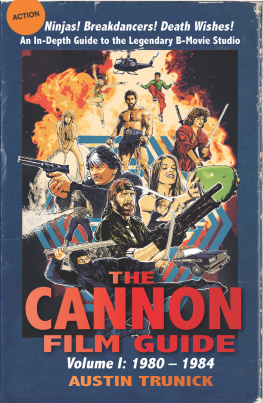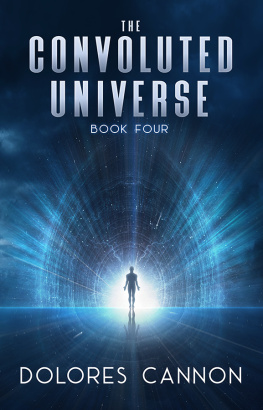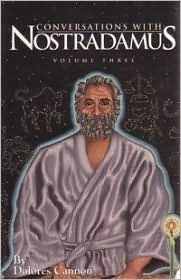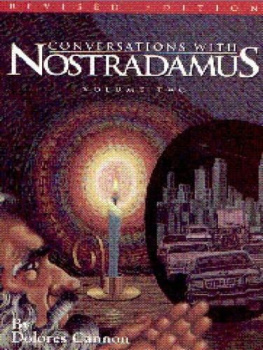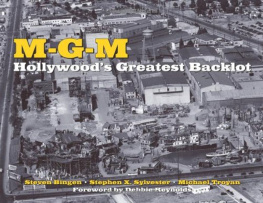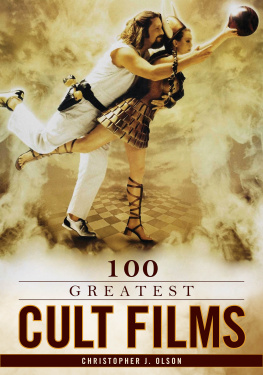Contents

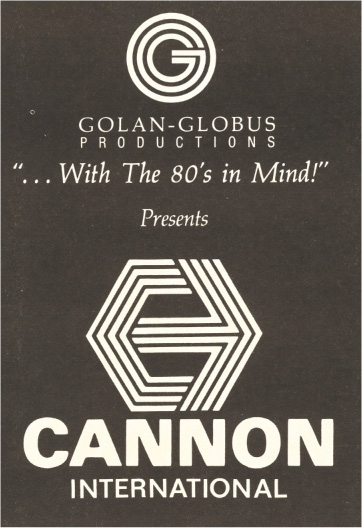
Golan and Globus celebrated their acquisition of Cannon with this full-page ad in Variety on May 9, 1979.
The Cannon Film Guide
Volume I (19801984)
Austin Trunick

Orlando, Florida
The Cannon Film Guide: Volume I, 19801984
Copyright 2020 Austin Trunick. All Rights Reserved.
No part of this book may be reproduced in any form or by any means, electronic, mechanical, digital, photocopying or recording, except for the inclusion in a review, without permission in writing from the publisher.
This book is an independent work of research and commentary and is not sponsored, authorized or endorsed by, or otherwise affiliated with, any motion picture studio or production company affiliated with the films discussed herein. All uses of the name, image, and likeness of any individuals, and all copyrights and trademarks referenced in this book, are for editorial purposes and are pursuant of the Fair Use Doctrine.
The views and opinions of individuals quoted in this book do not necessarily reflect those of the author.
The promotional photographs and publicity materials reproduced herein are in the authors private collection (unless noted otherwise). These images date from the original release of the films and were released to media outlets for publicity purposes.

Published in the USA by
BearManor Media
1317 Edgewater Dr. #110
Orlando, FL 32804
www.BearManorMedia.com
Softcover Edition
ISBN: 978-1-62933-580-3
Printed in the United States of America
Dedication
For my father, a man who enjoyed these sort of movies as much as I do.
Table of Contents
A Preservation of an Era:
Foreword by Sam Firstenberg
When I was a teenager attending high school in Israel during the 1960s, Menahem Golan was a household name all over the country. He directed some very popular Israeli movies in that period and always made sure that his name appeared above the title in big, bold letters in their advertisementsthey were always A Menahem Golan Film. I never met him in person until a chance meeting, far away from our mutual homeland, at a party in 1973 in Hollywood, California. I was attending film school at the time and he was preparing to produce and direct his first film in Hollywood. Golan impressed me right away as a very decisive man who made abrupt decisions with no hesitation. Looking for a break into the industry I asked him to join his production and he hired me to work on his production on the spot, without even blinking. Right away he impressed me as a very colorful man with a very loud and commanding personality. I worked for Menahem Golan in many different roles through the 1970s, from courier to production assistant to assistant director, and then as a feature film director beginning in the 1980s, after he and Yoram Globus acquired Cannon.
The creative atmosphere and the cinematic culture of Cannon were like no other film production organization of their time. There was a sense of openness and adventure amongst the rank and file of the employees, all emanating from the man at the top: Menahem Golan. Golan was the de facto, one-man creative department of the company and, in general terms, he was open and receptive to any crazy idea presented to him. Its not that every initiative taken ended up being a movie, but many did, and many were given the green light instantly, on the spot. Most of the other companiesmajors and independentwere rigid and hesitant in approving projects, making decisions via endless committees and group meetings and, as a result, were not willing to take unproven chances. At Cannon, the creative decisions were based on Golans gut feelings, and thats how they launched projects with Chuck Norris, Charles Bronson, John Cassavetes, and the likes of Runaway Train, Otello, American Ninja, Breakin, and on and on and on. Some of these projects were financially risky, but nevertheless they were made. Thats why so many moviemakers were attracted to work for Cannon.
In the 1960s, traditional, independent, low-budget exploitation and genre b-movies gave way to an emerging new wave of independent, expressive, and personal cinema and a different breed of American movies, the likes of Easy Rider, Midnight Cowboy, and so on. The major studios followed suit and started to produce more artistic, expressive, personal films, and Hollywood abandoned their bread and butter movies. Cannon Films seized on the opportunity and penetrated the vacuum that was created and, together with others, occupied this abandoned field. Certain types of audiences all over the world had felt betrayed and yearned for more of the old-fashioned genre flicks: action, horror, sci-fi, and the like. The 1980s also saw the emergence of the home video phenomenon, the videocassette tape rental economy and the rise to power of no major independent production and distribution companies to supply the product that was missing from the marketplace. Cannon became the largest of them all, producing more than 530 movies. At some point it was called a mini major.
In the 1990s, the major studios took notice of what was happening and started to produce the same type of movies that Cannon was making with the likes of Stallone, Schwarzenegger, Van Damme, and so on, but with much bigger budgets. Those new genre movies were much more elaborate, expensive, and better-looking, and consequently the majors reclaimed the market for themselves. By doing so, the majors pushed the independent companies back to the corners they came out of in the first place. Nowadays people talk about the Cannon look, and there is a renewed interest in the company and its movies. Moviegoers who grew up with those films in theaters or at home are nostalgic about the movies created by Cannon under the vision of Menahem Golan.
There is one thing for sure: Menahem Golan and Yoram Globus left a stamp on the popular culture of America and the world over. In studying the history of filmmaking in Hollywood, there was a capsule of about 15 years, through the 1980s and the first half of the 1990s, which can be characterized or branded as the period in which Cannon revolutionized the role of independent genre filmmaking in Hollywood. This is definitely one undeniable chapter in the ever-evolving history of cinema and its important to make sure it will not be forgotten. This book is an important block in this preservation endeavor.
Sam Firstenberg
Los Angeles, 2019
Sam Firstenberg is the director of numerous Cannon classics, including Revenge of the Ninja, Breakin 2: Electric Boogaloo, and American Ninja.
Preface
Like many of you, I grew up in the era when your whole weekends entertainment was decided during a Friday night trip to the video rental store. It was in those places where Cannon reigned supreme, and their recognizable logo could be found somewhere on almost every shelf in the store. Thanks to my local mom-n-pop shops lenient policies toward renting violent, R-rated movies to minors, I was exposed at a young age to film classics such as Invasion U.S.A

